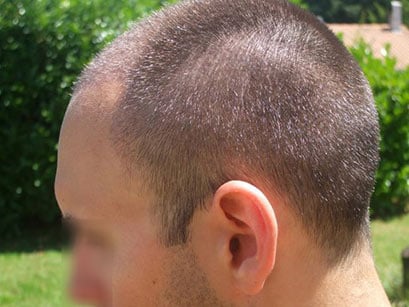1 - What is FUT hair transplant ?
The FUT hair transplant is a follicular transplant procedure.
It differs from FUE because extraction method is different.
In this case, a thin strip is taken from the middle of the donor area. Once removed, the grafts are isolated one by one with a microscope.
Implantation procedure is the same as FUE. The surgeon performs the incisions in which the follicular units are placed.
The extraction of the strip generates a thin linear scar in the donor area hidden by the surrounding hair. The trichophytic closure procedure greatly diminishes the scar visibility.
2 - What is FUE hair transplant ?
FUE is an innovative follicular technique that allows you to harvest grafts one by one on the total surface of the donor area.
Its main advantage is to leave no linear scar, but also to remove grafts where the FUT can not (for example on the sides). Due to the absence of a linear scar, patients receiving FUE can leave their hair short.
How long does the hair transplant procedure take ?
4 - Is the hair transplant painful?
5 - Will the scar be visible after a hair transplant?
It depends on the technique used to perform the hair transplant.
The FUT will leave a linear scar at the back of the head where the donor area is located. Nevertheless, the scar will not be visible once the hair has grown. The trichophyte suture systematically performed in our clinics, allows the hair to grow directly in the scar making it undetectable to plus or minus 80%.
The FUE will leave no linear scar, the isolations (made with a micro-punch) are so small that they will leave almost undetectable micro-scars. The advantage of the FUE is to be able to wear his hair very short without detectable traces of the intervention.
6 - How long does it take to see the first results of the hair transplant?
Hair growth is a time consuming and lenghtly process for each patient. Following the hair transplantation, the first signs of shoots can occur in the first 4 months, it is usually after 8 months that significant changes are seen and 1 year after the hair transplant that the final results appear. The use of PRP and Minoxidil significantly accelerates regrowth.
7 - How long does it take for the scalp to heal ?
After the operation, the scalp is sensitive and will remain red, it takes at least 10 days for the direct traces of the operation to disappear, the redness is variable according to the patients. It is possible to wear a hat to hide the traces of the hair transplant, but it must be wide and not interfere with the grafts. 90% of cases can resume a professional and social life in about ten days.
8 - What are the benefits of medical tourism for hair transplantation?
9 - Is the result permanent?
10 - What to do after a hair transplant?
11 - What are the contraindications to the hair implant ?
Medical contraindications are multiple and must be studied on a case by case basis, by a medical team that will be able to report contraindications.
Other cases in which the hair transplant is not recommended:
- Unrealistic patient expectations: a hair transplant helps fade the effects of androgenetic alopecia, but it can not rebuilt the hair as it was before.
- The state of the donor zone: if the donor area is insufficient or is affected by a hair loss, the hair transplant will not be able to give a satisfactory result.
- If medical treatments are enough to treat hair loss, it is not necessary to go for a hair transplant operation.











